Inside the life of Old Delhi's only female pigeon keeper
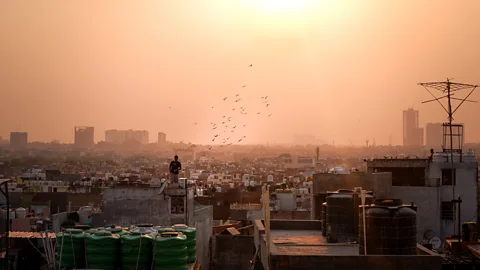 Shefali Rafiq
Shefali RafiqIn the male-dominated world of Delhi's kabootarbazi, one woman's passion for her birds has earned her respect, admiration – and a place in the sky.
As dusk descends on Old Delhi, the bustling streets grow even more crowded, with pedestrians inching forward through jam-packed streets and auto-rickshaws honking impatiently. But above the chaos, a quieter ritual takes flight. On rooftops across the old quarters, kabootarbaaz (pigeon keepers) release their cherished flocks into the sky. Whistles pierce the air and calls echo from rooftop to rooftop. And the birds respond, transforming the skyline into a swirling spectacle.
Pigeon keeping in Old Delhi is more than a pastime; it's an umbilical cord to the identity of Old Delhi that's rooted in the city's Mughal heritage. "A kabootarbaaz takes immense pride in their pigeons," says Ratnendu Ray, who conducts heritage walks in Delhi for the Indian National Trust for Art & Cultural Heritage (INTACH). "It's a sense of self, cultural identity and belonging."
 Shefali Rafiq
Shefali RafiqA living legacy
The tradition of pigeon keeping, known as kabootarbazi, dates to ancient times, tracing its roots to the era of the Mahabharata (between 400BC and AD200) when the birds were kept in palaces to entertain royalty. "Women of the court would often sit in their jharokhas (balconies) and watch the pigeons in flight," says author and historian Rana Safvi.
However, she explains, it was under the Muslim rulers that this pastime evolved into a popular sport.
"The sport reached its zenith under Emperor Jahangir, who likened kabutarbaazi to ishqbaazi (the art of love) and brought expert pigeon trainers to Delhi, elevating the tradition to a new level of refinement."
Thousands of pigeon keepers across the city carry on this tradition, rising through the ranks from shagird, or trainee, eventually rising to be a khalifa. "[They are] finally recognised by the fraternity as an ustaad – the highest level one can attain," says Ray.
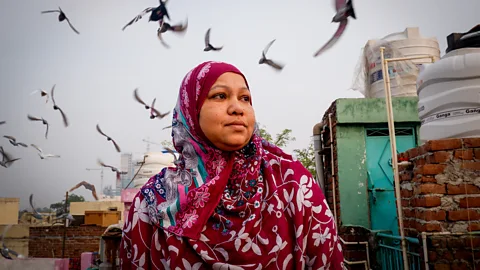 Shefali Rafiq
Shefali RafiqThe only woman in the sky
While kabootarbazi is traditionally a man's job passed down from father to son over the centuries, Shaheen Parveen has the distinction of being the only female pigeon keeper in Delhi.
In the neighbourhood of Khawaja Mir Dard Basti, Parveen transitions through various roles in a day, from devoted wife to mother to grandmother. However, as soon as she is alone, she climbs up the bamboo stairs that lead to the rooftop of her house, high above the crammed lanes where men savour kebabs frying in small eateries.
She starts her day inspecting her more than 100 pigeons, ensuring that each one is healthy before feeding them a custom grain mix. She then trains them through timed flights, using whistles or claps for recall. Evenings involve roll calls and nest checks; she also perfects their skills for competitions.
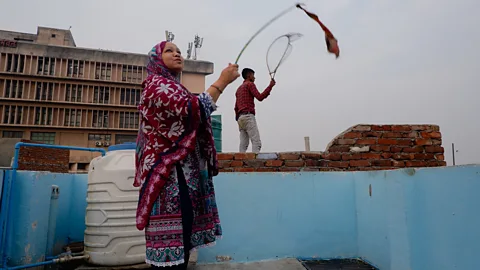 Shefali Rafiq
Shefali RafiqA voice above the rooftops
At sunset, Parveen's voice stands out from the myriad calls of men echoing for pigeons. As she raises her voice to the highest pitch, people peer out of their windows and from their terraces to catch a glimpse of their favourite pigeon keeper.
Being a kabootarbaaz is both tradition and passion, and Parveen says that spending time with the birds brings her a sense of peace and tranquillity. "If I don't spend time with them, I feel sick; they are like my children," she says.
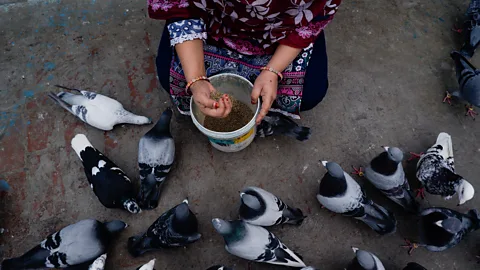 Shefali Rafiq
Shefali RafiqBreaking barriers
Parveen's rise to the respected status she now holds within the male-dominated community has been far from easy.
She credits her father for her love of the sport. "Every day after returning from school, he would take me to the rooftop to see his pigeons and that is when my love for the birds began," she says. However, she had to contend with the disapproval of her brother, who forbade her from pursuing the hobby. Later, she faced criticism from others who claimed it was unbecoming for a woman.
However, she persisted, driven by her love for the birds. "When your skills are praised and the community respects you for them, you feel uplifted, then the voices of those who speak against you don't matter," she says. "Let people say whatever they want to, I will continue doing what I want and what gives me peace."
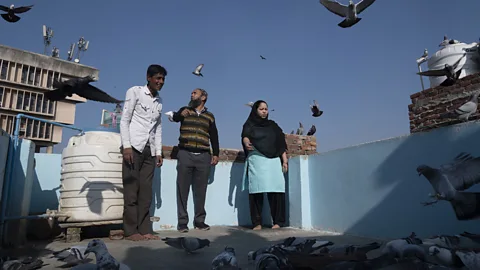 Shefali Rafiq
Shefali RafiqRespected in the community
Parveen has earned widespread respect across the community for her talents. "People see the visit of an experienced pigeon keeper to their roofs as a blessing; I receive many offers from people requesting me to bless their pigeons," she says with a smile. However, she usually declines these offers: "I don't get time from my own pigeons; also it is tiring."
Experienced pigeon keepers like Mohsin Ustaad take out time from their busy schedules to support Parveen with feed and medicine, expenses that she sometimes struggles to afford. "I came to her terrace because I respect her and have admiration for her skill," says Mohsin. Parveen smiles shyly: "It costs thousands of rupees – thankfully Mohsin helps us."
 Shefali Rafiq
Shefali RafiqA celebrated champion
Parveen's biggest triumph came when her pigeons won a major local race that drew hundreds of ustaads and hobbyists from Old Delhi and beyond – many of whom had trained their birds for months or years in preparation. In the race, the pigeons were released from a remote location and had to find their way back home. Judging was based on speed, endurance and how well the pigeons responded to their ustaad's calls.
More like this:
• Thirteen photos that will make you care about the ocean
• A 58-tunnel slow train through India's Eastern Ghats
• Witnessing the synchronised dance of a million starlings in Denmark
Race winners are awarded trophies, cash prizes and immense respect within the kabootarbazi community. Afterwards, scores of pigeon keepers presented Parveen with gifts. "Some even gave me money. It was like India had won the World Cup, some put garlands on me, I was nervous and happy," she says, showing videos and pictures of the event.
"People recognised her, she got more respect," her daughter adds.
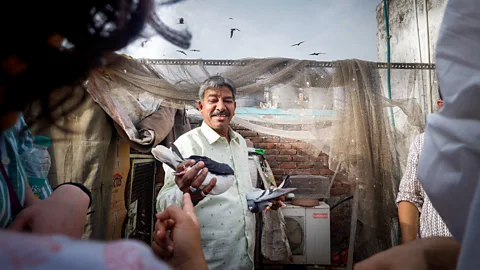 Shefali Rafiq
Shefali RafiqA rooftop attraction
Pigeon keeping has also become an attraction for travellers visiting Delhi, who are intrigued to see a way of life they may have seen in Bollywood movies but never witnessed for themselves.
Kabootarbaazi, Ray says, is governed by a rich set of social structures, unspoken rules and codes of conduct. "Pigeon-keepers often operate within specific territories, usually based around their neighbourhood or rooftop," he explains. "Venturing into territory of others is seen as disrespectful. There are also competitions and tournaments; witnessing all of it is a traveller's delight."
His heritage walk Prayer, power and pigeon: A heritage walk and kabootarbaz introduces visitors to this world, walking through the winding alleys between houses and watching the birds soaring through the open city skies.
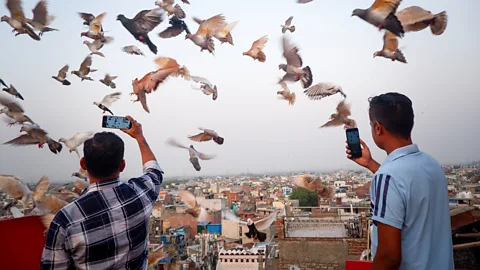 Shefali Rafiq
Shefali RafiqContent creators are also flocking to Old Delhi to capture the sight of the birds soaring and swirling in the sky. As they climb up to the terraces, seasoned pigeon keepers spring into action. They tighten their grip on the mesh used to guide the birds mid-flight with swift, practiced motions; they whistle, clap and call out in rhythmic chants.
The pigeons, mid-flight, respond in unison, veering back toward home, their wings slicing through the air in a synchronised dance. "I've been following pages of pigeon keepers on YouTube and other platforms for some time now," says Imran Ahmed, who came to take photos for his social media platforms. "Today, I'm glad to finally be among them, capturing photos and being photographed alongside these beautiful birds."
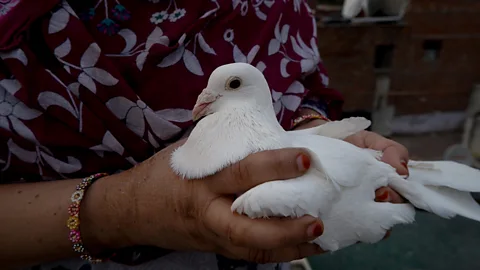 Shefali Rafiq
Shefali RafiqAn enduring bond
As the day ends, Parveen climbs to her terrace and lets her birds out. When they reach a certain height, she calls them to return. They respond right away. "I train each bird to recognise my voice, to know my call and trust me. It's a bond that you can't build overnight," Parveen explains, adjusting her pigeons' feed.
Though not an official ustaad yet, her skill and status are undeniable. "These birds feel my moods, and I feel theirs," she says, smiling. "In this world of feathers and sky, they know me as I know them. That's something no one can take from me."
--
If you liked this story, sign up for The Essential List newsletter – a handpicked selection of features, videos and can't-miss news, delivered to your inbox twice a week.
